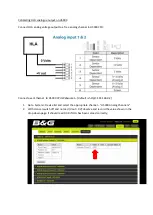
MICRO-ePUMP
World Precision Instruments
17
dye is dissolved in the injection fluid. The capillary effect may be observed with the
color change at the tip of the pipette. When the fluid flows into the pipette, the color
of the tip becomes lighter. If the compensation pressure is higher than the capillary
pressure, the fluid oozes out of the pipette. The solution around the pipette will be
colored. Adjusting the compensation pressure prevents this from happening.
Understanding how
capillary action causes the front filling of the pipette helps you to
correctly use the compensation pressure. The flow rate is determined by the capillary
action and the tip size. Since the tip size is often determined by the requirement of
the application, controlling the compensation pressure becomes the main option to
eliminate the uptake of fluid by capillary action.
NOTE:
The pressure of capillary action is determined by the inner diameter of
the glass capillary where the meniscus of air/liquid interface is located. It has
nothing to do with the pipette tip size.
If you assume the pipette tip is a cylindrical shape, the pressure of capillary action can
be described by the LaPlace equation:
P=4
γ
cos
θ
/d
γ
= surface tension
θ
= contact angle between the water and glass
d
= inner diameter of the capillary where the meniscus is
located
In most cases, we can assume the contact angle for glass and water is zero (unless
the glass surface is treated). From this equation we see that the smaller the inside
diameter, the greater the capillary action. The capillary pressure can vary a thousand
times when the meniscus is moved from a 0.5 µm ID tip to the 0.5 mm shank.
The pressure at 0.5 µm tip is about 80 PSI (in aqueous solution) while at the shank will
be only 0.08 PSI. Using one regulator to counterbalance the pressure in such a large
dynamic range is not practical. 10 PSI can counterbalance a meniscus at the section of
tip where the inner diameter is 4 µm.
In practice, this is the highest pressure ever needed. On the lower pressure end, it
becomes difficult to exactly counterbalance the capillary pressure when the meniscus
is at the shank of the pipette. However, a 0.1–0.2 PSI pressure imbalance will not
cause a significant problem if the tip is small enough. The gravity of the fluid and the
flow resistance caused by friction from the glass wall will both help to stop the solution
flow at this pressure level.
TIP
: If the lowest pressure setting is ineffective at preventing the pipette fluid from
leaking out, try setting the compensation pressure to zero to see if the gravity and
friction are sufficient to counterbalance the front fill.
TIP
: The capillary action can also be reduced by adding a hydrophobic fluid (such as
silicone oil) behind the hydrophilic saline solution. It can be completely eliminated by
silanizing the shank of the pipette (silanization increases the
θ
in the LaPlace equation
to 90º).
Содержание MICRO-ePUMP
Страница 2: ......
Страница 4: ...ii World Precision Instruments...
Страница 30: ...26 World Precision Instruments DECLARATION OF CONFORMITY...












































